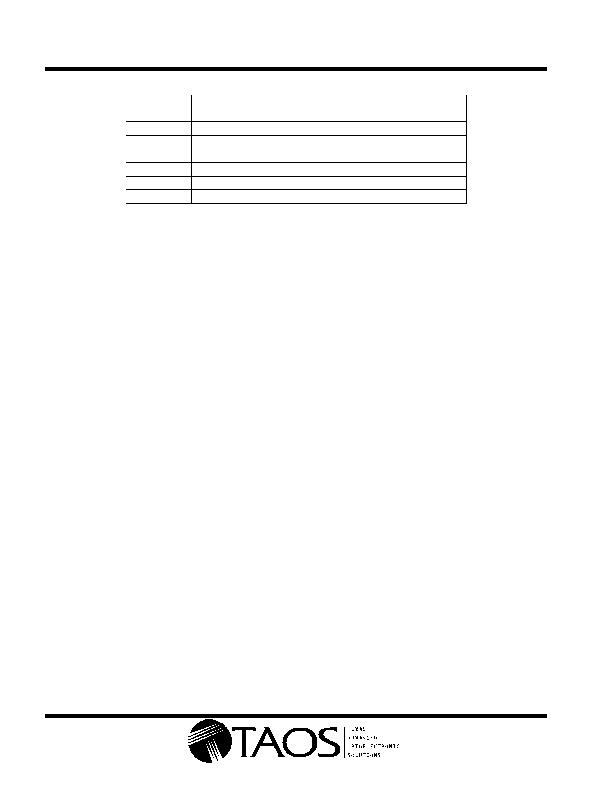- 您現(xiàn)在的位置:買賣IC網(wǎng) > Datasheet目錄57 > TSL1401CL (AMS-TAOS USA Inc)IC LINEAR SENSOR ARRAY 128X1 CL Datasheet資料下載
參數(shù)資料
| 型號: | TSL1401CL |
| 廠商: | AMS-TAOS USA Inc |
| 文件頁數(shù): | 3/17頁 |
| 文件大?。?/td> | 637K |
| 描述: | IC LINEAR SENSOR ARRAY 128X1 CL |
| 標準包裝: | 1 |
| 系列: | * |
| 其它名稱: | TSL1401-CLDKR TSL1401-CLDKR-ND |

TSL1401CL
128 ?1 LINEAR SENSOR ARRAY WITH HOLD
TAOS136 JULY 2011
2
r
r
Copyright E 2011, TAOS Inc.
The LUMENOLOGY r Company
www.taosinc.com
Terminal Functions
TERMINAL
NAME
NO.
DESCRIPTION
AO
3
Analog output.
CLK
2
Clock. The clock controls charge transfer, pixel output, and reset.
GND
6, 7
Ground (substrate). All voltages are referenced to the substrate.
NC
5, 8
No internal connection.
SI
1
Serial input. SI defines the start of the data-out sequence.
V
DD
4
Supply voltage. Supply voltage for both analog and digital circuits.
Detailed Description
The sensor consists of 128 photodiodes arranged in a linear array. Light energy impinging on a photodiode
generates photocurrent, which is integrated by the active integration circuitry associated with that pixel.
During the integration period, a sampling capacitor connects to the output of the integrator through an analog
switch. The amount of charge accumulated at each pixel is directly proportional to the light intensity and the
integration time.
The output and reset of the integrators is controlled by a 128-bit shift register and reset logic. An output cycle
is initiated by clocking in a logic 1 on SI. For proper operation, after meeting the minimum hold time condition,
SI must go low before the next rising edge of the clock. An internal signal, called Hold, is generated from the
rising edge of SI and transmitted to analog switches in the pixel circuit. This causes all 128 sampling capacitors
to be disconnected from their respective integrators and starts an integrator reset period. As the SI pulse is
clocked through the shift register, the charge stored on the sampling capacitors is sequentially connected to a
charge-coupled output amplifier that generates a voltage on analog output AO. Simultaneously, during the first
18 clock cycles, all pixel integrators are reset, and the next integration cycle begins on the 19
th
clock. On the
129
th
clock rising edge, the SI pulse is clocked out of the shift register and the analog output AO assumes a
high impedance state. Note that this 129
th
clock pulse is required to terminate the output of the 128
th
pixel, and
return the internal logic to a known state. If a minimum integration time is desired, the next SI pulse may be
presented after a minimum delay of t
qt
(pixel charge transfer time) after the 129
th
clock pulse.
AO is an op amp-type output that does not require an external pull-down resistor. This design allows a rail-to-rail
output voltage swing. With V
DD
= 5 V, the output is nominally 0 V for no light input, 2 V for normal white level, and 4.8 V
for saturation light level. When the device is not in the output phase, AO is in a high-impedance state.
The voltage developed at analog output (AO) is given by:
V
out
= V
drk
+ (R
e
) (E
e
)(t
int
)
where:
V
out
is the analog output voltage for white condition
V
drk
is the analog output voltage for dark condition
R
e
is the device responsivity for a given wavelength of light given in V/(糐/cm
2
)
E
e
is the incident irradiance in 糤/cm
2
t
int
is integration time in seconds
A 0.1 糉 bypass capacitor should be connected between V
DD
and ground as close as possible to the device.
The TSL1401CL is intended for use in a wide variety of applications, including: image scanning, mark and code
reading, optical character recognition (OCR) and contact imaging, edge detection and positioning, and optical
linear and rotary encoding.
相關PDF資料 |
PDF描述 |
|---|---|
| TSL1401CS-LF | IC OPTO SENSOR ARRAY CSP PCB MT |
| TSL1402R | IC LINEAR SENSOR ARRAY 256X1 |
| TSL1406RS | IC LINEAR SENSOR ARRAY 768X1 |
| TSL1410R | IC LINEAR SENSOR ARRAY 1280X1 |
| TSL1412S | IC LINEAR SENSOR ARRAY 1536X1 |
相關代理商/技術參數(shù) |
參數(shù)描述 |
|---|---|
| TSL1401CS | 制造商:未知廠家 制造商全稱:未知廠家 功能描述:128 1 LINEAR SENSOR ARRAY WITH HOLD |
| TSL1401CS-LF | 功能描述:光頻率和光電壓 Linear Sensor Array 400dpi 128pix RoHS:否 制造商:ams 峰值波長:1000 nm 工作電源電壓:5 V 最大工作溫度:+ 85 C 最小工作溫度:- 25 C 安裝風格: 封裝 / 箱體: |
| TSL1401R | 功能描述:光頻率和光電壓 Linear Sensor Array 400dpi 128pix RoHS:否 制造商:ams 峰值波長:1000 nm 工作電源電壓:5 V 最大工作溫度:+ 85 C 最小工作溫度:- 25 C 安裝風格: 封裝 / 箱體: |
| TSL1401R-LF | 功能描述:光頻率和光電壓 Linear Sensor Array 400dpi 128pix RoHS:否 制造商:ams 峰值波長:1000 nm 工作電源電壓:5 V 最大工作溫度:+ 85 C 最小工作溫度:- 25 C 安裝風格: 封裝 / 箱體: |
| TSL1401USBEVM | 功能描述:光學傳感器開發(fā)工具 TSL1401 Eval Module with USB Interface RoHS:否 制造商:ams 工具用于評估: 接口類型: 最大工作溫度: |
發(fā)布緊急采購,3分鐘左右您將得到回復。